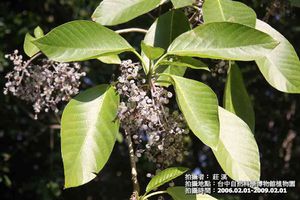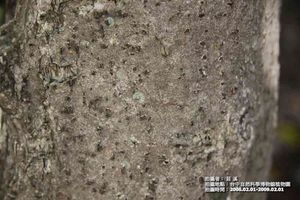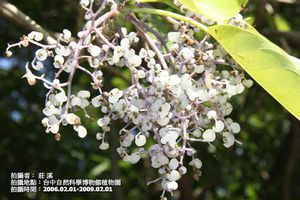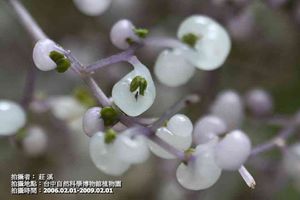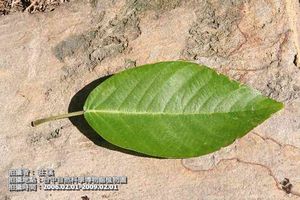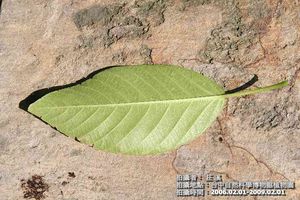咬人狗
出自台灣有毒中草藥毒性資料庫
(→毒性分級) |
|||
| (4個中途的修訂版本沒有顯示) | |||
| 第1行: | 第1行: | ||
| - | [http://tcm-toxic.kmu.edu.tw/index.php/%E8%95%81%E9%BA%BB%E7%A7%91 | + | __NOTOC__ |
| - | {{:模板:基本資料|1=蕁麻科 Urticaceae|2=咬人狗屬|3= 'Dendrocnide | + | {| |
| + | ||[http://tcm-toxic.kmu.edu.tw/index.php/%E5%AD%B8%E5%90%8D 中英文學名] | ||
| + | |||
| + | ||[http://tcm-toxic.kmu.edu.tw/index.php/%E8%95%81%E9%BA%BB%E7%A7%91 科別] | ||
| + | |||
| + | ||[http://tcm-toxic.kmu.edu.tw/index.php/%E6%AF%92%E6%80%A7 毒性] | ||
| + | |||
| + | ||[http://tcm-toxic.kmu.edu.tw/index.php/%E7%97%87%E7%8B%80 症狀] | ||
| + | |} | ||
| + | {{:模板:基本資料|1=蕁麻科 Urticaceae|2=咬人狗屬|3= 'Dendrocnide'|4=咬人狗|5=''Dendrocnide meyeniana'' (Walp.) Chew, Gard. Bull. Singapore|6=Batan wood nettle |7= 刺暈}} | ||
(1) | (1) | ||
| + | |||
== '''植物圖片''' == | == '''植物圖片''' == | ||
| + | <font size=4> | ||
{| border="2" style="border-collapse;" | {| border="2" style="border-collapse;" | ||
|| | || | ||
| 第32行: | 第43行: | ||
咬人狗-葉-葉背 | 咬人狗-葉-葉背 | ||
|} | |} | ||
| + | </fnot> | ||
| - | |||
| - | |||
| + | == '''咬人狗簡介''' == | ||
| + | <font size=4> 咬人狗是蕁麻科火麻樹屬的多年生常綠的草本植物,在台灣低海拔山區常見於中南部,此株植物的葉部具含矽/鈣的刺毛與珠狀腺體,當皮膚觸碰到咬人狗後可能會導致皮膚搔癢、疼痛及刺痛感(2, 3)。 | ||
</font>。 | </font>。 | ||
| + | |||
== '''外觀簡述''' == | == '''外觀簡述''' == | ||
{| border="2" style="border-collapse;" | {| border="2" style="border-collapse;" | ||
|| | || | ||
| - | <font size= | + | <font size=4>'''莖'''</font> |
| - | ||<font size= | + | ||<font size=4> 常綠小喬木,被焮毛,高達5~7公尺,徑達15公分,嫩枝頂端被短柔毛。 </font> |
|- | |- | ||
|| | || | ||
| - | <font size= | + | <font size=4>'''葉'''</font> |
| - | ||<font size= | + | ||<font size=4> 為單葉,互生,具葉炳,柄被毛,細長,長約3~10公分;葉片長約10~40公分,寬約6~20公分,長橢圓狀卵形,葉尖尾狀漸尖形,葉基略呈契形或近圓形。 </font> |
|- | |- | ||
|| | || | ||
| - | <font size= | + | <font size=4>'''花'''</font> |
| - | ||<font size= | + | ||<font size=4> 為單性花;聚繖花序,腋生,有長梗;雄花約7~11朵,叢生而藏於外部有毛之苞片內,花被約3~4裂.裂片有緣毛,雄蕊3~4枚;雌花花柱細長,有毛。 </font> |
|- | |- | ||
|| | || | ||
| - | <font size= | + | <font size=4>'''果實'''</font> |
| - | ||<font size= | + | ||<font size=4> 果實為瘦果,扁平,斜形或略圓型。 </font> |
|} | |} | ||
| + | |||
== '''產地''' == | == '''產地''' == | ||
| - | <font size= | + | <font size=4> |
分布於菲律賓,在台灣地區分佈在蘭嶼以及綠島之陰濕叢林內(1)。 | 分布於菲律賓,在台灣地區分佈在蘭嶼以及綠島之陰濕叢林內(1)。 | ||
</font> | </font> | ||
| + | |||
== '''毒性研究''' == | == '''毒性研究''' == | ||
| - | <font size= | + | <font size=4>根據文獻報告指出當皮膚觸碰到咬人狗的植株時會引起皮膚之搔癢及疼痛感等等之感受,在一篇案例報告指出一位14歲的男性左手臂觸碰到咬人狗後造成皮膚搔癢,而後擴展至身體上,持續的搔癢及灼熱感造成病患睡眠障礙,最後導致身體、頸部以及四肢會搔癢的紅斑性丘疹,經醫師證實為自體敏感性皮膚炎(2)。</font> |
| - | *<font size= | + | *<font size=4 color=green>'''機轉'''</font> |
| - | <font size= | + | <font size=4> 目前對於觸碰咬人狗所導致皮膚搔癢、疼痛以及刺痛感或是急性皮膚炎之機轉尚未被確認,經文獻報導指出可能是因為珠狀腺體中的蟻酸所導致的,但在案例報告指出,觸碰咬人狗後不只導致局部性的皮膚發炎,而後轉變成自體敏感性皮膚炎擴展至軀幹以及四肢(2, 4, 5)。然而自體敏感性皮膚炎的發病機制被認為可能與增加HLA-DR-以及IL-2R陽性T淋巴球有相關(6)。 </font> |
| + | |||
| + | *<font size=4 color=green>'''有毒成份'''</font> | ||
| + | <font size=4> 經文獻報導指出觸碰咬人狗後所導致的急性皮膚炎可能是珠狀腺體中的蟻酸有機酸所引起的(4, 5)。 </font> | ||
| - | |||
| - | |||
=='''治療方式'''== | =='''治療方式'''== | ||
| - | <font size= | + | <font size=4>在臨床上治療由植物引起的皮膚炎之治療原則大多是使用全身性或是局部性的類固醇進行治療,或給予口服的抗組織胺來減輕其相關症狀(2, 7, 8)。然而在Chang et al的文獻報告指出根據中國傳統醫學的理論和藥理學的研究使用消風散(Xiao-feng–san)以及麻黃解毒湯(Huang-lian-jie-du-tang),可緩解皮膚之損傷以及消去紅疹(2)。 </font> |
| + | |||
=='''毒性分級'''== | =='''毒性分級'''== | ||
| - | <font size= | + | <font size=4>[http://tcm-toxic.kmu.edu.tw/index.php/%E6%AF%92%E6%80%A7%E5%88%86%E9%A1%9E 級數B]</font> |
| + | |||
== '''參考文獻''' == | == '''參考文獻''' == | ||
| + | <font size=4> | ||
1. 台灣植物誌第二版編輯委員會. 台灣植物誌 第二版. 台北: 台灣植物誌第二版編輯委員會 1993.2: 204. | 1. 台灣植物誌第二版編輯委員會. 台灣植物誌 第二版. 台北: 台灣植物誌第二版編輯委員會 1993.2: 204. | ||
| - | 2. Chang YT, Shen JJ, Wong WR, Yen HR. Alternative therapy for autosensitization dermatitis. Chang Gung | + | 2. Chang YT, Shen JJ, Wong WR, Yen HR. [http://www.ncbi.nlm.nih.gov/pubmed/20035647 Alternative therapy for autosensitization dermatitis.] ''Chang Gung Medical Journal'' 2009;32(6):668-73. |
| - | 3. Fu HY, Chen SJ, Kuo-Huang LL. Comparative study on the stinging trichomes and some related epidermal structures in the leaves of Dendrocnide meyeniana, Girardinia diversifolia, and Urtica thunbergiana. | + | 3. Fu HY, Chen SJ, Kuo-Huang LL. [http://tai2.ntu.edu.tw/taiwania/abstract.php?id=17 Comparative study on the stinging trichomes and some related epidermal structures in the leaves of ''Dendrocnide meyeniana'', ''Girardinia diversifolia'', and ''Urtica thunbergiana''.] ''Taiwania'' 2003;48(4):213-23. |
| - | 4. Fu HY, Chen SJ, Chen RF, Ding WH, Kuo-Huang LL, Huang RN. Identification of oxalic acid and tartaric acid as major persistent pain-inducing toxins in the stinging hairs of the nettle, Urtica thunbergiana. | + | 4. Fu HY, Chen SJ, Chen RF, Ding WH, Kuo-Huang LL, Huang RN. [http://aob.oxfordjournals.org/content/98/1/57.abstract Identification of oxalic acid and tartaric acid as major persistent pain-inducing toxins in the stinging hairs of the nettle, ''Urtica thunbergiana''.] ''Annals of Botany'' 2006;98(1):57-65. |
| - | 5. Taskila K, Saarinen JV, Harvima IT, Harvima RJ. Histamine and LTC4 in stinging nettle-induced urticaria. Allergy | + | 5. Taskila K, Saarinen JV, Harvima IT, Harvima RJ. [http://www.ncbi.nlm.nih.gov/pubmed/10921474 Histamine and LTC4 in stinging nettle-induced urticaria.] ''Allergy'' 2000;55(7):680-1. |
| - | 6. Kasteler JS, Petersen MJ, Vance JE, Zone JJ. Circulating activated T lymphocytes in autoeczematization. | + | 6. Kasteler JS, Petersen MJ, Vance JE, Zone JJ. [http://archderm.ama-assn.org/cgi/content/abstract/128/6/795 Circulating activated T lymphocytes in autoeczematization.] ''Archives of Dermatology'' 1992;128(6):795-8. |
| - | 7. Canavan D, Yarnell E. Successful treatment of poison oak dermatitis treated with Grindelia spp. (Gumweed). | + | 7. Canavan D, Yarnell E. [http://www.ncbi.nlm.nih.gov/pubmed/16131296 Successful treatment of poison oak dermatitis treated with ''Grindelia spp''. (Gumweed).] ''Journal of Alternative and Complementary Medicine'' 2005;11(4):709-10. |
8. Corporation. S. Nursing herbal medicine handbook. 3rd ed. . Philadelphia: Lippincott Williams & Wilkins; 2006. | 8. Corporation. S. Nursing herbal medicine handbook. 3rd ed. . Philadelphia: Lippincott Williams & Wilkins; 2006. | ||
| + | </font> | ||
| + | {| | ||
| + | ||[http://tcm-toxic.kmu.edu.tw/index.php/%E5%AD%B8%E5%90%8D 中英文學名] | ||
| - | [http://tcm-toxic.kmu.edu.tw/index.php/%E8%95%81%E9%BA%BB%E7%A7%91 | + | ||[http://tcm-toxic.kmu.edu.tw/index.php/%E8%95%81%E9%BA%BB%E7%A7%91 科別] |
| + | |||
| + | ||[http://tcm-toxic.kmu.edu.tw/index.php/%E6%AF%92%E6%80%A7 毒性] | ||
| + | |||
| + | ||[http://tcm-toxic.kmu.edu.tw/index.php/%E7%97%87%E7%8B%80 症狀] | ||
| + | |} | ||
在2012年7月3日 (二) 12:27的最新修訂版本
| 中英文學名 | 科別 | 毒性 | 症狀 |
基本資料
|
科別 | 蕁麻科 Urticaceae |
|
屬名 | 咬人狗屬 Dendrocnide |
|
中文學名 | 咬人狗 |
|
拉丁學名 | Dendrocnide meyeniana (Walp.) Chew, Gard. Bull. Singapore |
|
英文名稱 | Batan wood nettle |
|
中文俗名 | 刺暈 |
(1)
植物圖片
|
咬人狗 |
咬人狗莖 |
咬人狗-瘦果1 | |
|
咬人狗-瘦果2 |
咬人狗-葉正 |
咬人狗-葉-葉背 |
</fnot>
咬人狗簡介
咬人狗是蕁麻科火麻樹屬的多年生常綠的草本植物,在台灣低海拔山區常見於中南部,此株植物的葉部具含矽/鈣的刺毛與珠狀腺體,當皮膚觸碰到咬人狗後可能會導致皮膚搔癢、疼痛及刺痛感(2, 3)。 。
外觀簡述
|
莖 | 常綠小喬木,被焮毛,高達5~7公尺,徑達15公分,嫩枝頂端被短柔毛。 |
|
葉 | 為單葉,互生,具葉炳,柄被毛,細長,長約3~10公分;葉片長約10~40公分,寬約6~20公分,長橢圓狀卵形,葉尖尾狀漸尖形,葉基略呈契形或近圓形。 |
|
花 | 為單性花;聚繖花序,腋生,有長梗;雄花約7~11朵,叢生而藏於外部有毛之苞片內,花被約3~4裂.裂片有緣毛,雄蕊3~4枚;雌花花柱細長,有毛。 |
|
果實 | 果實為瘦果,扁平,斜形或略圓型。 |
產地
分布於菲律賓,在台灣地區分佈在蘭嶼以及綠島之陰濕叢林內(1)。
毒性研究
根據文獻報告指出當皮膚觸碰到咬人狗的植株時會引起皮膚之搔癢及疼痛感等等之感受,在一篇案例報告指出一位14歲的男性左手臂觸碰到咬人狗後造成皮膚搔癢,而後擴展至身體上,持續的搔癢及灼熱感造成病患睡眠障礙,最後導致身體、頸部以及四肢會搔癢的紅斑性丘疹,經醫師證實為自體敏感性皮膚炎(2)。
- 機轉
目前對於觸碰咬人狗所導致皮膚搔癢、疼痛以及刺痛感或是急性皮膚炎之機轉尚未被確認,經文獻報導指出可能是因為珠狀腺體中的蟻酸所導致的,但在案例報告指出,觸碰咬人狗後不只導致局部性的皮膚發炎,而後轉變成自體敏感性皮膚炎擴展至軀幹以及四肢(2, 4, 5)。然而自體敏感性皮膚炎的發病機制被認為可能與增加HLA-DR-以及IL-2R陽性T淋巴球有相關(6)。
- 有毒成份
經文獻報導指出觸碰咬人狗後所導致的急性皮膚炎可能是珠狀腺體中的蟻酸有機酸所引起的(4, 5)。
治療方式
在臨床上治療由植物引起的皮膚炎之治療原則大多是使用全身性或是局部性的類固醇進行治療,或給予口服的抗組織胺來減輕其相關症狀(2, 7, 8)。然而在Chang et al的文獻報告指出根據中國傳統醫學的理論和藥理學的研究使用消風散(Xiao-feng–san)以及麻黃解毒湯(Huang-lian-jie-du-tang),可緩解皮膚之損傷以及消去紅疹(2)。
毒性分級
參考文獻
1. 台灣植物誌第二版編輯委員會. 台灣植物誌 第二版. 台北: 台灣植物誌第二版編輯委員會 1993.2: 204.
2. Chang YT, Shen JJ, Wong WR, Yen HR. Alternative therapy for autosensitization dermatitis. Chang Gung Medical Journal 2009;32(6):668-73.
3. Fu HY, Chen SJ, Kuo-Huang LL. Comparative study on the stinging trichomes and some related epidermal structures in the leaves of Dendrocnide meyeniana, Girardinia diversifolia, and Urtica thunbergiana. Taiwania 2003;48(4):213-23.
4. Fu HY, Chen SJ, Chen RF, Ding WH, Kuo-Huang LL, Huang RN. Identification of oxalic acid and tartaric acid as major persistent pain-inducing toxins in the stinging hairs of the nettle, Urtica thunbergiana. Annals of Botany 2006;98(1):57-65.
5. Taskila K, Saarinen JV, Harvima IT, Harvima RJ. Histamine and LTC4 in stinging nettle-induced urticaria. Allergy 2000;55(7):680-1.
6. Kasteler JS, Petersen MJ, Vance JE, Zone JJ. Circulating activated T lymphocytes in autoeczematization. Archives of Dermatology 1992;128(6):795-8.
7. Canavan D, Yarnell E. Successful treatment of poison oak dermatitis treated with Grindelia spp. (Gumweed). Journal of Alternative and Complementary Medicine 2005;11(4):709-10.
8. Corporation. S. Nursing herbal medicine handbook. 3rd ed. . Philadelphia: Lippincott Williams & Wilkins; 2006.
| 中英文學名 | 科別 | 毒性 | 症狀 |
